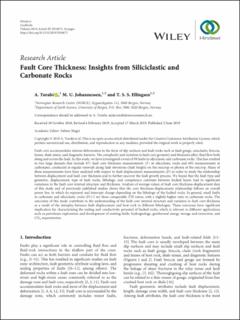| dc.description.abstract | Fault core accommodates intense deformation in the form of slip surfaces and fault rocks such as fault gouge, cataclasite, breccia, lenses, shale smear, and diagenetic features. The complexity and variation in fault core geometry and thickness affect fluid flow both along and across the fault. In this study, we have investigated a total of 99 faults in siliciclastic and carbonate rocks. This has resulted in two large datasets that include 871 fault core thickness measurements in siliciclastic rocks and 693 measurements in carbonates, conducted at regular intervals along fault elevations (fault height) on the outcrop or photos of the outcrop. Many of these measurements have been analyzed with respect to fault displacement measurements in order to study the relationship between displacement and fault core thickness and to further uncover the fault growth process. We found that the fault type and geometry, displacement, type of fault rocks, lithology, and competency contrasts between faulted layers lead to significant variations in the fault core internal structure and thickness. Analysis of average values of fault core thickness-displacement data of this study and of previously published studies shows that the core thickness-displacement relationship follows an overall power law, in which its exponent and intercept change depending on the lithology of the faulted rocks. In general, small faults in carbonate and siliciclastic rocks ( m) show comparable ratios, with a slightly higher ratio in carbonate rocks. The outcomes of this study contribute to the understanding of the fault core internal structure and variation in fault core thickness as a result of the interplay between fault displacement and host rock in different lithologies. These outcomes have significant implication for characterizing the sealing and conductivity potential of faulted rocks, which is relevant to different applications such as petroleum exploration and development of existing fields, hydrogeology, geothermal energy storage and extraction, and CO2 sequestration. | |

